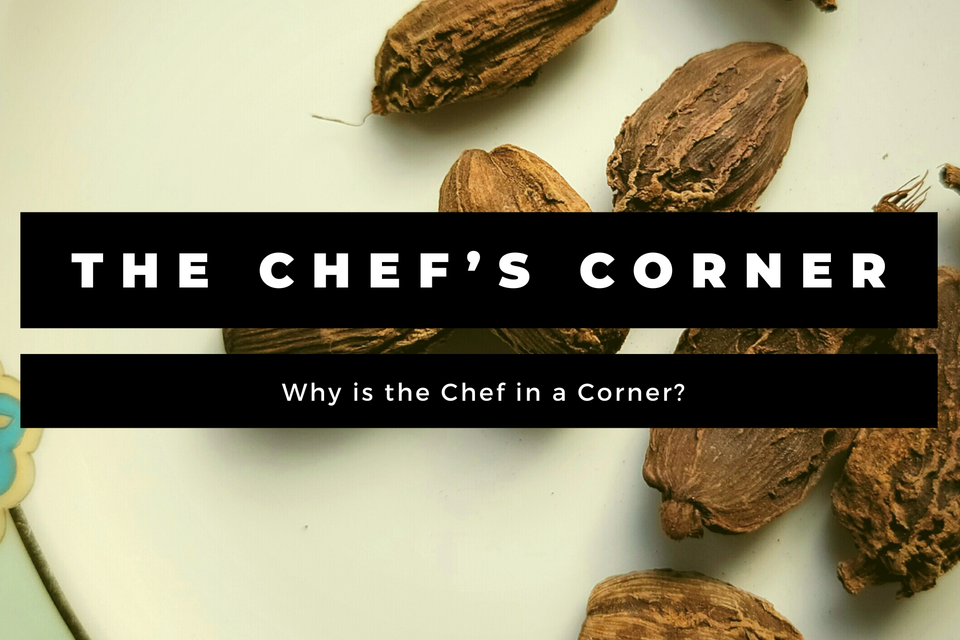By Hari Pulapaka, PhD, WCMC, CECNovember 2, 2021Why is the Chef in a Corner? After spending well over a decade in my little restaurant kitchen fully immersed in getting sh!t done, I’m ready to bust out of my corner.
Each week, I will pass judgment on a segment of food news that may or may not be interesting, shed light on a seasonal (for us) food ingredient or two, and dream up some minutiae about a spice I love and think you should, too.
In true elitist fashion, I will share a recipe with you, because academia is in my blood and academics think everything they do or say is supremely relevant and important.
I am here to champion the worth of food while fighting for flavor and the people who help provide food on our tables. What percentage of Americans eat at the dining table these days? It has been on the decline for the past decade because by many measures, “the kitchen ate the dining room.”
Judging the News On Nov. 1, 2021, the world’s oldest and most famous (tire-manufacturer-backed) restaurant guide — The Michelin Guide — announced that in Spring 2022, they will launch the first-ever MICHELIN Guide for Florida, covering restaurants in Miami, Orlando, and Tampa.
The deal is an undisclosed partnership (people got paid) between Michelin and Visit Florida. One would expect Visit Orlando to also be involved in the deal.
Back in 2012, when ZAGAT launched its inaugural Orlando Guide, a certain DeLand restaurant took top honors — much to the chagrin and horror of a few, but not in the least bit surprising to many of us.
Exactly what would a Michelin Star mean for a restaurant? Surprisingly, more than it perhaps should. The fact is, enough foodies chase dining experiences in formally rated restaurants and this can mean a significant uptick in revenues, growth, and offshoot concepts.
One doesn’t need a reminder of the devastation wreaked by a global pandemic on independent restaurants here and everywhere. What the heck! I’m all for boosting the real reputation of our best restaurants.
Meanwhile, starred or not, there are scores of dining establishments that need your continued support, patience, and kindness.
What’s Growing in Central Florida Now? It’s a bountiful time for produce in Central Florida, as late summer holdouts co-exist with early fall arrivals. An entirely reasonable, in-season ratatouille comes to mind, because, after all, this is Florida. With the second-longest coastline of any state in the United States, seafood rules in Florida.
Speaking of ruling, I recently visited my supplier friends at King’s Seafood in New Smyrna Beach looking for fresh, traceably sustainable seafood. The uber-sustainable Wreckfish (they name it Deepwater Seabass for marketing purposes) is beautiful. For lesser options, consider lionfish, mackerel, or sheepshead. I have a love/hate relationship with lionfish and will focus on this conundrum in an upcoming column.
Of course, there are the local shrimp. Given the availability of late-summer produce, a Provençal-style, lemony, herbaceous shrimp ragout with pan-roasted Florida Wreckfish would be the seafood star of any restaurant’s menu.
Local Ingredient of the Week
EGGPLANT
Growing up in India, eggplant was known to me as vankaya — the Telugu word for brinjal. When my friend Dom Rodi talked about aubergine on the golf course, only later did I realize that he was referring to baingan.
The East Asian variety of eggplant is very cook-friendly because it is thin-skinned and consequently, cooks very easily, has a custard-like feel and the skin is rarely bitter. This seems like an appropriate metaphor for life some days.
Eggplant is native to India and, as one can imagine, is an extremely popular vegetable in all the regional cuisines. Below, I share a recipe for an eggplant dish that makes my mouth water from mere memory.
Global Spice of the Week:
BLACK CARDAMOM
Black cardamom is a common spice in Indian cuisine. It is a larger variety of cardamom which is dried over an open fire, giving it its distinctive smoky flavor.
For cooking, it is best suited in small quantities for low and slow, moist cooking methods — such as a braised dish.
Smokestacks of wood fire drying black cardamom dot the hillside drives up and down the lower Himalayas near Darjeeling and Sikkim in India. Do you know how I know this? Because Jenneffer and I found this sight and aroma a welcome distraction during our edgy car ride to the airport at the end of our visit to the region in 2011.
Also, it’s 2021 and we’ve been through a lot, so would everyone please refrain from using the phrase “Chai Tea”? — because chai is already … tea. It would, however, be a good name for the red panda cub that was born in the Darjeeling Zoo earlier this year.
Recipe of the Week:
Stewed Eggplant, Coconut, and Potato
Saving a most meaningful food memory for last, this is my interpretation of the bhaji (“vegetable” or “vegetable dish” in a number of Indian languages) I had with my family when we played wedding-crashers after the Bombay-Baroda cricket match at Brabourne Stadium in 1972.
To this day, I can taste the warm puris (puffy fried bread) and this bhaji on a balmy evening, as a 6-year-old. I have no idea how the cooks made it then, but the flavors here bring me a lot of comfort.
Servings: 4
INGREDIENTS4 cups eggplant, large diced
2 medium-sized ripe tomatoes, medium diced
2 Yukon Gold potatoes, washed, skin on, large diced, boiled in salted water until just cooked
1/2 cup unsweetened grated coconut (available in the frozen section)
1 tablespoon fresh ginger, minced
1 tablespoon fresh garlic, minced
1 medium red onion, medium diced
1/2 teaspoon whole cumin seeds (if available)
1/2 teaspoon whole mustard seeds
1 whole black cardamom
1/2 teaspoon turmeric powder
1 teaspoon coriander powder
1/2 teaspoon ground cayenne (more or less)
2 tablespoons vegetable or extra virgin olive oil
1 cup water, as needed
1/4 cup chopped fresh cilantro
12 large Florida shrimp, peeled and deveined (optional)
salt - to taste
METHOD
- Coat the eggplant liberally with half the oil, season with salt, and roast on a baking sheet for 20 minutes in a preheated 400F oven. Turn the eggplant once during this process for even roasting. Remove and set aside.
- To a wide and shallow pan on medium heat, add the remaining oil, and heat until warm. Add the whole black cardamom, mustard seeds, and cumin seeds. The mustard seeds will pop! Stir for 30 seconds before adding the onions and ginger.
- Cook the onions until they are translucent (about 5 minutes).
- Add the garlic and stir for 30 seconds. The fresh coconut goes in next — stir it for a couple of minutes.
- Add the turmeric powder, coriander powder, and cayenne. Stir for a few seconds before adding the tomatoes and some salt. Cover and cook for 10 minutes on medium-low heat.
- Add the cooked potatoes, roasted eggplant, and some water. Cover and stew for 15 minutes, stirring periodically.
- (optional) If you are using shrimp, add them to the pan, stir well and cover. As soon as the shrimp are opaque, turn off the heat and keep the pan covered.
- Taste for salt and adjust as desired. Just before serving, stir in the fresh cilantro.
- Discard the black cardamom or rinse, dry, and reuse it at least one more time.
NOTE: The black cardamom is not edible unless you like the flavor of resin, camphor, and menthol all at once.
Photo Credit: Hari Pulapaka
About Chef Hari



